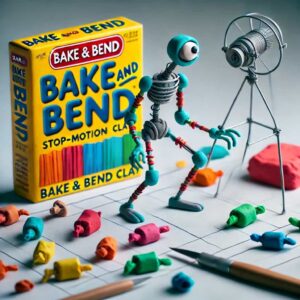Claymation is a fascinating art form where characters and scenes are brought to life using stop-motion animation. A critical factor for success in claymation is choosing the right clay. If you’ve been asking is bake and bend clay good for claymation, this article will provide a clear and detailed answer.
What Is Bake and Bend Clay?
Bake and Bend clay is a type of polymer clay designed to remain flexible after baking. Unlike traditional polymer clay that hardens completely, this material retains a pliable texture, allowing for slight bending and movement without breaking.
Key Characteristics of Bake and Bend Clay
- Pliable After Baking: Maintains flexibility, making it less prone to cracking.
- Bright Colors: Available in vibrant shades that are ideal for creating characters.
- Durable Finish: Resistant to breakage even when manipulated.
Is Bake and Bend Clay Good for Claymation?

The suitability of Bake and Bend clay for claymation depends on your specific needs. Let’s examine the pros and cons to determine whether it’s a good choice.
Advantages of Bake and Bend Clay for Claymation
- Flexibility After Baking:
- Bake and Bend clay retains a soft, rubbery texture, making it ideal for animating movements without cracks or chips.
- Easy to Mold:
- Its pliability makes it easy to shape intricate details, from facial expressions to limbs.
- Durability:
- Figures crafted with Bake and Bend clay can withstand repeated handling during stop-motion animation.
- Lightweight:
- This clay is lighter compared to traditional polymer clays, which helps when positioning figures for animation.
- Color Variety:
- The vibrant colors reduce the need for extensive painting, speeding up the preparation process.
Drawbacks of Bake and Bend Clay for Claymation
- Limited Rigidity:
- While flexibility is an advantage, some claymation projects require firmer clay for stability during animation. Bake and Bend may not hold its shape well for large or heavy figures.
- Heat Sensitivity:
- After baking, the material is still somewhat heat-sensitive, which can cause warping under strong studio lights.
- Challenging for Small Details:
- Tiny or delicate details may not hold as well due to its inherent softness.
How to Use Bake and Bend Clay for Claymation
If you choose Bake and Bend clay for your project, follow these tips to maximize its potential:
- Bake Properly:
- Follow the manufacturer’s instructions for baking to achieve the desired flexibility.
- Avoid overbaking, which can reduce its pliability.
- Use Wire Armatures:
- Add internal wire armatures for stability and to support larger or more complex figures.
- Handle with Care:
- Keep figures away from heat sources like studio lights for long periods to prevent softening.
- Combine with Other Materials:
- For projects requiring both rigidity and flexibility, use Bake and Bend clay for movable parts (e.g., limbs) and a firmer clay for the core structure.
Who Should Use Bake and Bend Clay for Claymation?
Best For:
- Beginners: Easy to work with and forgiving for trial and error.
- Flexible Animations: Ideal for characters that require frequent repositioning.
- Small Projects: Perfect for short or simple claymation films.
Not Ideal For:
- Large Productions: Advanced animators may prefer a combination of firmer materials for professional-grade projects.
- Intricate Details: Projects with highly detailed miniatures may need firmer clays for precision.
FAQs
What makes Bake and Bend clay unique for claymation?
Its flexibility after baking allows for movement and repositioning without cracking, making it great for animated characters.
Does Bake and Bend clay work for detailed figures?
It’s good for moderate details, but very fine or intricate designs might require firmer clay.
Can Bake and Bend clay hold up under strong lights?
While it’s durable, prolonged exposure to heat from studio lights can cause slight warping.
Should I use armatures with Bake and Bend clay?
Yes, wire armatures provide added stability, especially for larger or more complex figures.
Is Bake and Bend clay beginner-friendly?
Absolutely. Its soft texture and forgiving nature make it ideal for newcomers to claymation.
What are the best alternatives to Bake and Bend clay for claymation?
Firmer polymer clays like Super Sculpey or oil-based clays like Plastilina are excellent for more intricate or professional projects.
Final Thought
To answer is bake and bend clay good for claymation, the verdict is clear: it depends on your project’s needs. This clay is an excellent choice for beginners and projects requiring flexibility and durability. However, for intricate designs or large-scale productions, you might need a combination of clays.
Bake and Bend clay’s versatility, bright colors, and ease of use make it a valuable tool in the animator’s toolkit. With the right techniques and preparation, it can help bring your claymation creations to life.
If you want to read more articles , you can click here !












